Work order management is key to keeping your field service business operating smoothly. It also plays an integral role in customer satisfaction and overall productivity. But managing work orders, especially at high volumes, isn’t always easy, and you need an effective process that works well for your business.
An ideal work order process consists of three phases:
- A new work order is created, and the process begins
- That work order progresses through your business, prompting scheduling, an appointment, and a resolution
- The work order is closed and completed, often with the generation and payment of an invoice
The process might seem simple, but if you’ve been managing a work order process for any amount of time, you understand that executing the process well is far more complicated than it appears.
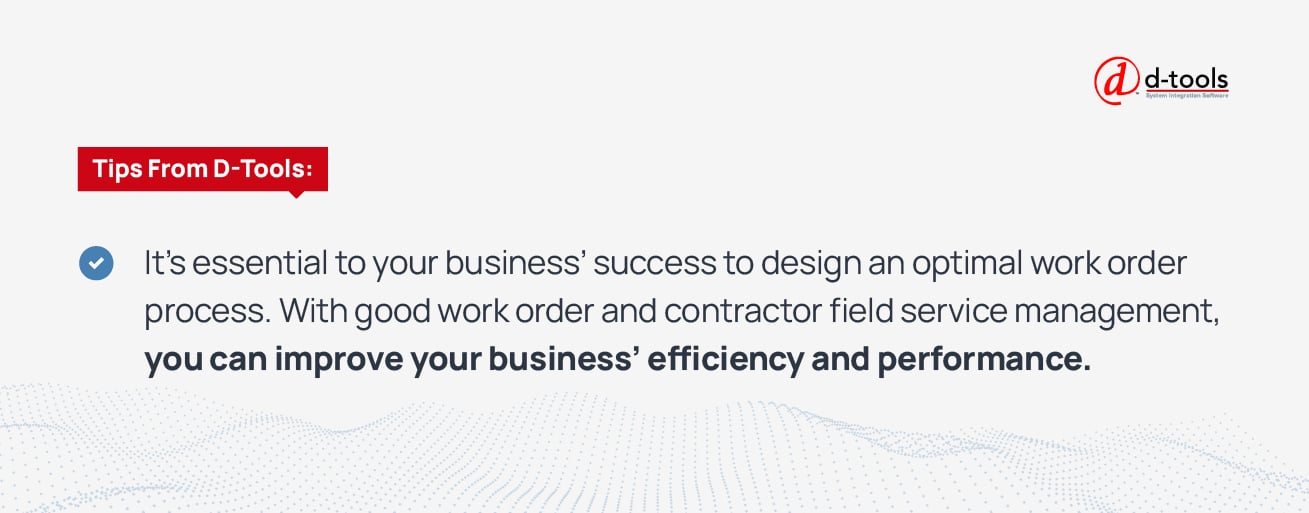
But designing an optimal work order process is essential to your business’ success. With good work order and electronic systems contractor field service management, you can improve your business’ efficiency and performance. That leads to increased customer satisfaction and a chance to acquire recurring customers and even customer referrals.
When your work order process needs improvement, it can lead to significant issues for your business. Lost work orders, delayed appointment scheduling, extended issue diagnostic times, and more trouble can result from poor work order management. Your field service team's performance and business' reputation can suffer as a result.
Whether you’re having problems with your process or want to make your work order management as good as possible, these tips on how to keep track of work orders can help. You can integrate these tips into your existing process, or design a new management process from scratch based on these tips.
Step 1: Invest in Work Order Software for Contractors
Before you make any other changes to your work order process, start by investing in quality software. Having the right software available to your team will make all of the following steps easier to implement and more effective.
Your work order software serves as your entire team’s central hub. It’s what connects your office staff with your field technicians, and all elements of your work order process should be recorded in the software. This creates a detailed record for every work order, and it helps to ensure that nothing is missed or overlooked.
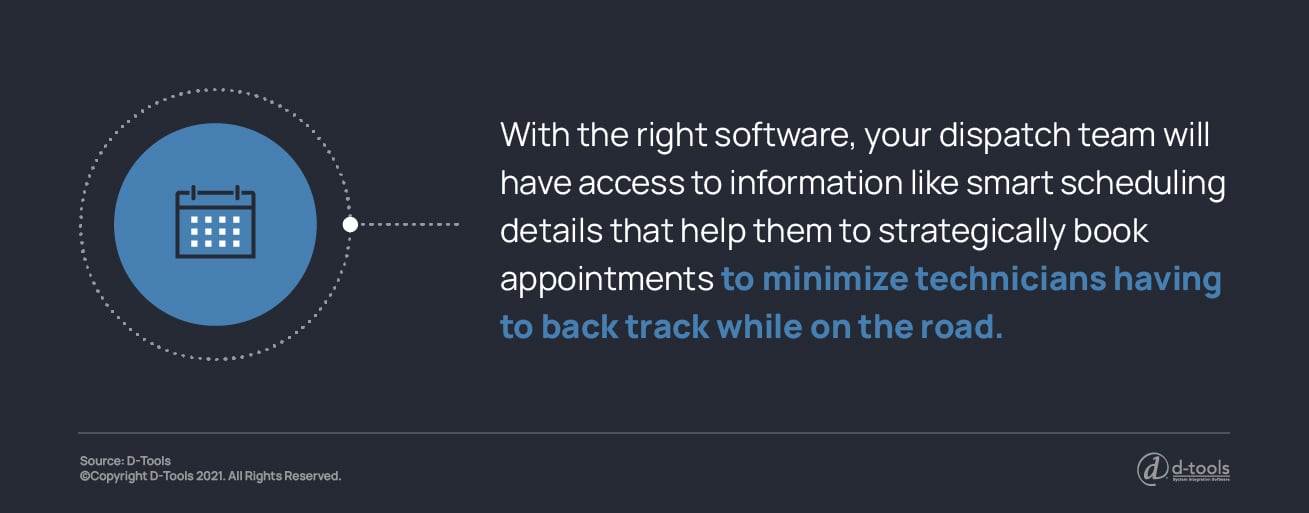
With the right software, your team will have valuable tools that help them to do their jobs better and more efficiently. Your dispatch team will be able to promptly schedule appointments, and they’ll have access to information like smart scheduling details that help them to strategically book appointments to minimize technicians having to backtrack while on the road.
Once your technicians reach the appointment location, they can access information about the customer’s previous appointments, the most recent fixes, and prior diagnostics that can help them to better troubleshoot the current issue.
Your work order software also offers valuable time-saving benefits in terms of the real-time updates it offers. Your office team can tell at a glance where a field technician is and what progress has been made on an appointment. This allows your team to update customers who have the following appointments, keeping everyone running on schedule so that your work orders continue through processing.
Step 2: Centralize Your Work Order Data
Depending on the age of your systems and processes, you might receive work orders in various forms through different outlets. They might be emailed, submitted via an online form, faxed over, and more. This can make for a chaotic intake process.
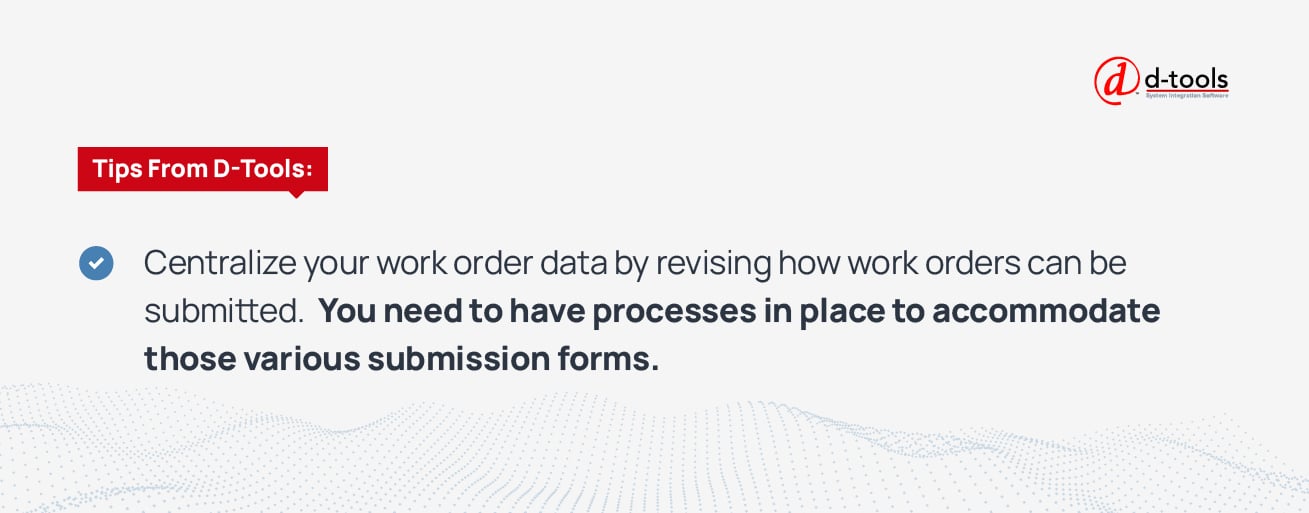
Start by revising how work orders can be submitted. It’s fine to accept work orders that are submitted in all of the above forms (and more), but you need to have processes in place to accommodate those various submission forms.
This is easier if you ensure that all work orders are consistent. Revise your forms so that any work order you receive is in the same format, with the same information in the same order.
Put plans in effect to ensure that all work orders are processed appropriately. This might mean routing all electronic work orders right through your scheduling software. If you’re accepting work orders through fax, then you’ll need procedures in place to ensure that the fax machine is manually checked at specific times each day. Opting for an e-fax system that can also be kept digital might be a better option and can help to ensure that faxed work orders aren’t overlooked.
Step 3: Determine How to Categorize Priorities
Any work order deserves prompt attention, but some work orders are more urgent than others. Being able to prioritize those truly urgent work orders can help to keep your customers happy and demonstrates that they can depend on your business to help them when they most need it.
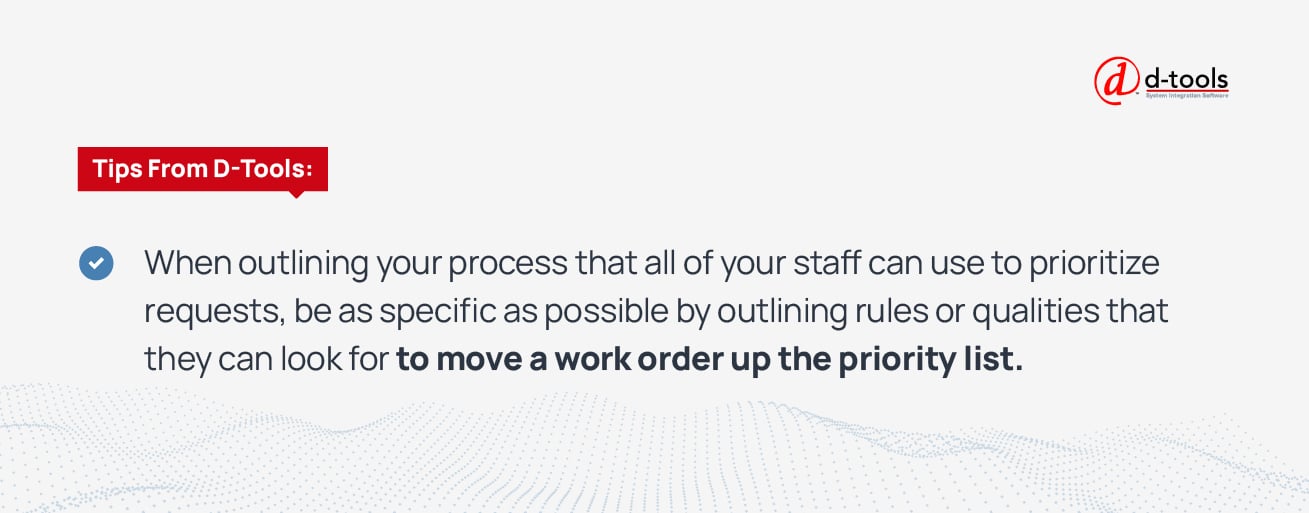
But leaving your staff to use their own judgement when prioritizing work orders is asking for inconsistency. Instead, it’s much more important to determine a process that all of your staff can use to prioritize these requests.
When outlining this process, be as specific as possible. Try to outline rules or qualities that staff can look for to move a work order up the priority list. These factors will vary depending on your business and your customers, so talk with your scheduling and dispatch team and discuss the types of work orders they request and how they’re currently prioritizing them. You may be able to use their current process as a basis for your more formal process.
As you develop and outline this process, think about the situations your team might encounter and the guidance they’ll need to successfully handle those situations. Are there certain customers who should always receive priority treatment? Is it ever acceptable to reschedule an existing appointment to accommodate a more urgent need? The more detail you can use to define the process that you want your team to follow, the better they’ll be able to fulfill your requests.
Step 4: Determine an Assignment Strategy
As work orders come in, they need to be received, processed, and scheduled. Put some procedures in place to ensure that this is a smooth operation. For example, if you’re using field service management software, you can often set that software to send a notification when new workers arrive. This allows the staff member tasked with reading and processing work orders to promptly begin that process.
Before your staff can schedule an appointment, they need to be able to determine which field technician is best for the job. This is particularly important when you have technicians who specialize in certain systems or repairs, or when just certain technicians have specific equipment in their vehicles. If a customer is requesting additional service or a follow-up to a previous appointment that didn’t solve their issue, then it may be helpful and important to send the same technician out again.
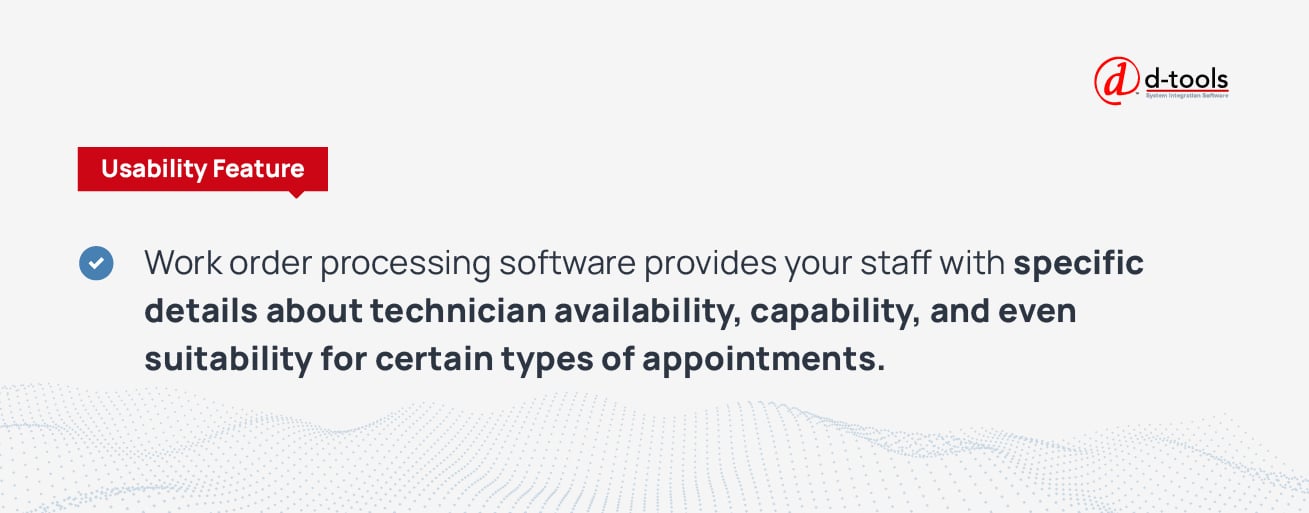
Tracking all this information can be difficult, and there’s plenty of room for human error that can lead to frustrated customers and wasted appointments. Instead, consider using work order processing software that provides your staff with specific details about technician availability, capability, and even suitability for certain types of appointments. You can always make your team a “cheat sheet” that highlights each technicians’ specialties and talents, but relying on your software for this same type of assistance can save time.
Step 5: Use Tools to Support Your Scheduling
Your team can schedule appointments more accurately and faster with the right field service scheduling software. A quality platform will let your entire team see technicians’ availability for easy scheduling.
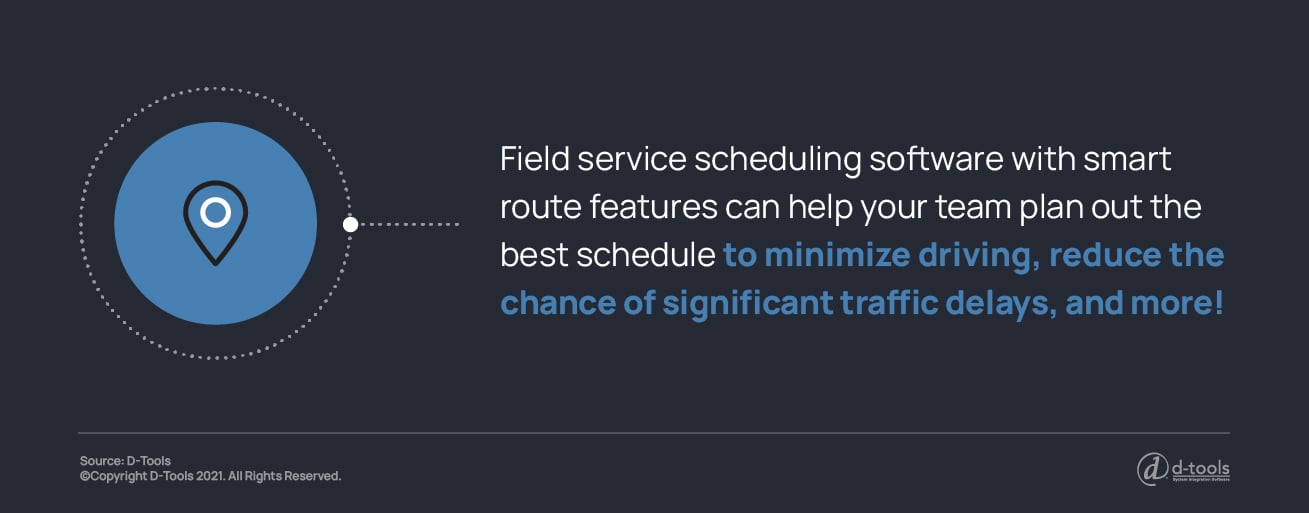
When that platform also offers smart route features, it can help your team plan out the best schedule to minimize driving. This saves technicians time on the road and reduces the chance of significant traffic delays. It maximizes the billable hours they work during a day and can boost your company’s profit margins.
Using a centralized work order management platform can also ensure that technicians are working from the most up-to-date version of the day’s schedule. While a schedule might change several times throughout the day, your entire team can view it live, so there are no accidentally missed appointments because someone refers to the previous version.
Step 6: Effectively Communicate with Customers
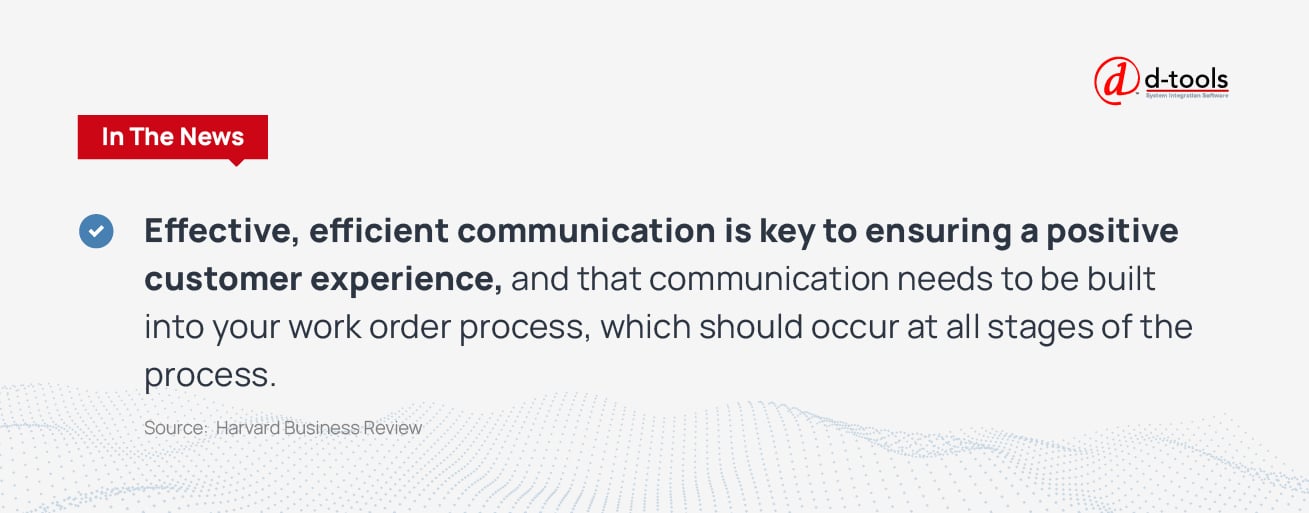
Prompt service order processing and scheduling is great, but if you’re not then communicating that information to customers, you could still be eroding customer trust in and satisfaction with your business. Effective, efficient communication is key to ensuring a positive customer experience, and that communication needs to be built into your work order process.
The communication should really occur at all stages of the process. Consider setting up automated text or email confirmations to customers that verify the work order has been received. Include some information about processing time, particularly if a work order is received outside of regular business hours.
Once the appointment is scheduled, that needs to be communicated to a customer. A phone call from your team is an appropriate and valued communication strategy in this stage. Your team members can confirm with the customer that the appointment time works for them, can gather any necessary information, and can answer any questions a customer might have at this stage. Hearing an appointment has been scheduled from a human, rather than an automated message, can help to reassure customers and gives them a chance to express any concerns they might have.
That communication needs to continue up to, through, and after the appointment. Automated email, text, and phone appointment reminders can help ensure the customer is available for their appointment.
On the day of the appointment, provide customers with updates as your technicians work through the schedule. This is easy when you’re using software that lets your office team track appointment progress and each technician’s location. By calling customers and letting them know the technician is running a little ahead of schedule or a little behind, you’re demonstrating how much you value their time.
After the appointment, continue that communication with a customer satisfaction survey. Be sure to include a field where customers can input custom answers. The information that you collect through these surveys can help you to ensure optimal customer service, and it can also help you to identify areas where your work order process might need improvements.
Step 7: Upgrade Your Work Order Software
You can implement all of the above tips, but if your work order software is out of date or lacks functionality, it will be difficult to truly improve your work order process.
There are plenty of software options to choose from, so make sure that your software is truly a good fit for your company. Consider which features are most important to your business, and what other problems your software might solve. Software not only makes for more efficient work order processing, but can also help with everything from increasing customer satisfaction to more effective inventory management.
Options like D-Tools System Integrator and D-Tools Cloud, can accomplish these tasks, as well as plenty of others. Learn how D-Tools’ software can add efficiency to your processes. Request a demo today.


